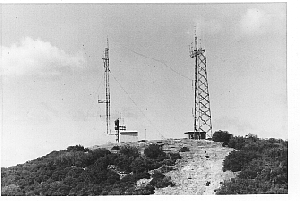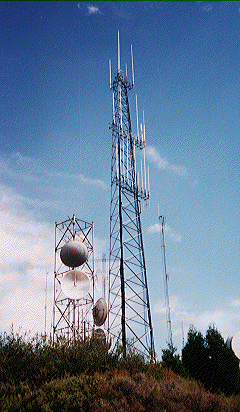|
|
|
The picture below on the left was taken in 1971 and is looking west at the site before the Cactus building and tower were built. The Rhone 45 tower on the left side is the same tower shown in the new picture (on the right) just to the right of the Cactus tower. The long way to the site was to take the road that wound around to the left and up the backside of the site. The fast route was to drive up the fire break clearing shown in this picture. It was steep enough that 4 wheel drive and running start were required (but it was more fun than the back side).
The picture below on the right is looking southeast towards the site. The large tower was donated brand new to the Cactus Radio Club. The tower sections were moved from the valley floor to the mountain top. A cement truck was hired to drive up to the site and pour the tower foundations but never made it. The truck driver got scared by the dirt road, dumped the concrete load over the side of the mountain and drove back down. Cactus not only had to pay for the concrete that was never received but then had to hand mix and pour 15 yards of 3500PSI certified concrete under the supervision of a hired non-ham inspector. Two one sack mixers were used, which each mixed 1/5 yard of concrete at a time. The workers manually shoveled the exact correct amount of sand, gravel, cement and water under the inspectors eagle eye. An error of one shovel full of sand could cause the whole mix to fail the 3500PSI shear test that a sample of each pour was subjected to. The tower foundations were poured and the tower assembled on the site all by Cactus volunteer members. The bottom 20 foot section was installed on the foundations by hand. The remaining 20 foot tower sections were assembled on the ground and a rented stinger crane lifted each section up and placed them on growing tower. Three (3) tower climbers, one on each leg, bolted the sections together and then climbed up and waited for the next section. The crossarms were then lifted into place with a truck winch using a pully on the top of the tower.
 |

|
The site was designed from the begining, to be a community site with common receive antennas as well as common transmit antennas. This required a major engineering effort to design the receiver and transmitter combiners. A weather proof box was mounted at the top of the tower which housed preamps and cavities for the common receive antennas to maintain maximum receiver performance. Most of the engineering was developed and built by Robin, WA6CDR, and Chip, N6CA.
|
|
This picture shows the 420 individual transmitter filter cavities and some of the receiver cavities which follow the 420 receive multicoupler all mounted in the rafters out of the way of all the radios. To the left, just out of the picture, is the high performance 20 port distributed gain GaAs FET 440 MHz receive multicoupler which uses exclusively Chip Angles GaAs FET preamps and splitters. The Cactus radios are in the blue cabinet and the one open frame rack to the left. The N6DD remote is in the cabinet to the right of the blue cabinet. |
The Sunset Ridge radio consists of a Palomar Telecom Controller, a Motorola Micor exciter, driving a special Cactus Standard 28 volt 1 watt in to 80 watt output power amplifier. The link radios consist of Motorola Mitreks as transmitters and two (2) GE MASTR Pro wideband receivers.
|
|
|
Return to:
|
|
|